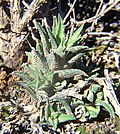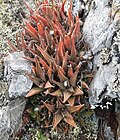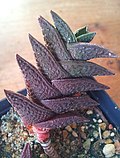| Section | Image | Scientific name | Description | Distribution |
|---|
| Attenuatae |  | Haworthiopsis attenuata (Haw.) G.D.Rowley | | South Africa (southern Cape Provinces) |
|---|
| Haworthiopsis |  | Haworthiopsis coarctata (Haw.) G.D.Rowley | small, smooth, rounded tubercles | South Africa (southern Cape Provinces) |
|---|
 | Haworthiopsis fasciata (Willd.) G.D.Rowley | has a light color, and fibrous leaves with glabrous inner surfaces | South Africa (southern Cape Provinces) |
 | Haworthiopsis glauca (Baker) G.D.Rowley | has a blue ("glaucous") colour | South Africa (southern Cape Provinces) |
 | Haworthiopsis longiana (Poelln.) G.D.Rowley | has long, thin, elongated leaves | South Africa (southern Cape Provinces) |
 | Haworthiopsis reinwardtii (Salm-Dyck) G.D.Rowley | has larger, flatter, whiter tubercles, and is often more slender than H. coarctata | South Africa (southern Cape Provinces) |
| Limifoliae |  | Haworthiopsis limifolia (Marloth) G.D.Rowley | has splayed leaves usually with raised lateral lines or wrinkles on the leaf surfaces | Eswatini, southern Mozambique, South Africa (KwaZulu-Natal, Northern Provinces) |
|---|
| Koelmaniorum |  | Haworthiopsis koelmaniorum (Oberm. & D.S.Hardy) Boatwr. & J.C.Manning | has scabrid, dark brown opaque leaves | South Africa (Mpumalanga) |
|---|
| Tessellatae |  | Haworthiopsis granulata (Marloth) G.D.Rowley | | South Africa (Cape Provinces) |
|---|
 | Haworthiopsis tessellata (Haw.) G.D.Rowley | | Namibia, South Africa (Cape Provinces, Free State, Northern Provinces) |
 | Haworthiopsis venosa (Lam.) G.D.Rowley | has visible veins on its upper leaf surfaces | South Africa (south-western Cape Provinces) |
| Haworthiopsis woolleyi (Poelln.) G.D.Rowley | | South Africa (southern Cape Provinces) |
| Trifariae |  | Haworthiopsis nigra (Haw.) G.D.Rowley | has a dark colour and concolorous tubercles | South Africa (southern Cape Provinces) |
|---|
 | Haworthiopsis pungens (M.B.Bayer) Boatwr. & J.C.Manning | has hard, sharp ("pungent") leaf tips | South Africa (southern Cape Provinces) |
 | Haworthiopsis scabra (Haw.) G.D.Rowley | a stemless species with a rough scabrid leaf surface | South Africa (south-western and south-south-western Cape Provinces) |
 | Haworthiopsis viscosa (L.) Gildenh. & Klopper | has a lighter brown mat surface, and no tubercles | South Africa (Cape Provinces) |
| Virescentes |  | Haworthiopsis bruynsii (M.B.Bayer) G.D.Rowley | Has evolved a retuse shape, but is nonetheless a member of the genus. | South Africa (southern Cape Provinces) |
|---|
 | Haworthiopsis sordida (Haw.) G.D.Rowley | has dark, dusty ("sordid") leaves with rounded tips | South Africa (southern Cape Provinces) |
|





















